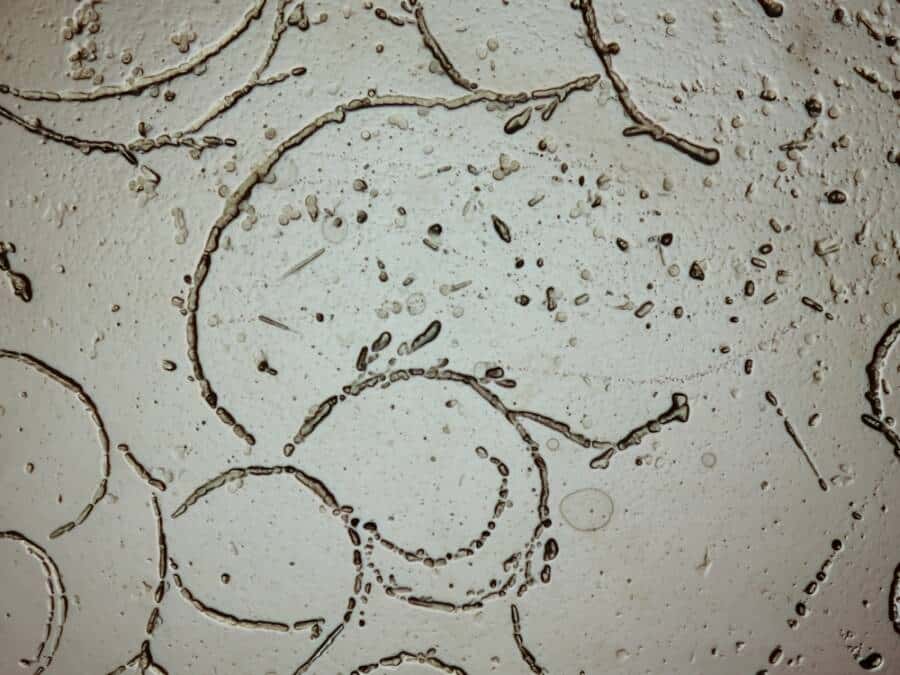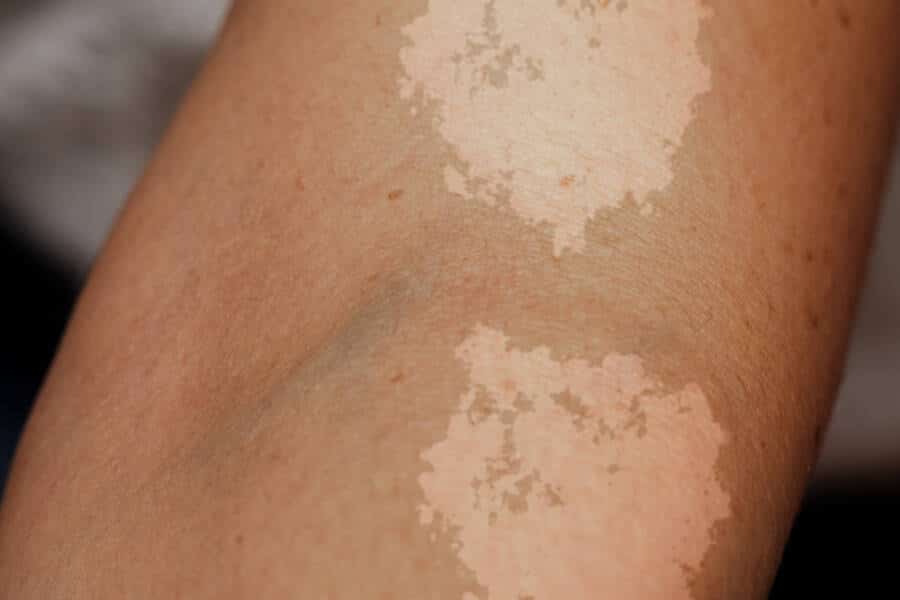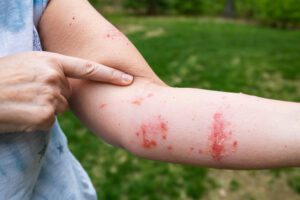Get to Know and Recognize What A Fungal Infection Looks Like
Whether we’re talking about intense itchiness or redness, fungal infections are a certain type of skin infection caused by the proliferation of microscopic fungal germs found at the level of our mucocutaneous flora. Luckily, there are plenty of antifungal treatments that can be applied locally and that allow for the overall regeneration of the skin, quite rapidly.
What is a fungal skin infection?
As mentioned before, fungal skin infections are a certain type of cutaneous infections caused by an abnormal increase in the microscopic fungi found on the surface of our skin. They generally target the skin, but they can also be found in certain hairy areas of our body. There are three main types of yeast that are responsible for causing such infections: candida, dermatophyte, and Malassezia.

Doctor’s take on skin infections
According to doctor Jérémy Lupu, a renowned dermatologist, “Skin fungal infections can be seen in the form of dry, red, and squamous plaques. They also have circular edges. In fact, we can say that the interior of the lesion is healed.
You might notice that these plaques are either unique or in multiple batches. Oftentimes, these skin infections itch.” He also explained how these types of mycoses also target skin integuments, such as angles and hair.
In those areas with hair growth, you can see how they might provoke alopecia where the skin fungus expands. Also, the mycosis that you find in those areas where skin folds (such as in your groin area or around breasts), tend to be quite itchy and easily turn red.
Types of fungal skin infections
There are three main types of fungal skin infections. They differ depending on the pathogen that caused them: candidosis, dermatophytosis, or Malassezia fungi. Here, we will break down each and every one of them, discuss the various areas around your body where you might see them, and treatment alternatives.
Candida mycosis
A skin infection caused by candida can show up on any part of your body. Moreover, patients who are immunocompromised suffer from an increased risk of developing these types of fungi on their skin. Moreover, the other type of candida, the vag*nal one (also known as yeast infection) can be found in women who are very healthy. These are some of the most common types of Candida:
Oral thrush
Oral thrush, also known as oral candidiasis, is a common condition in which the fungus Candida albicans accumulates on the lining of your mouth. Candida is quite a common organism in your mouth, but sometimes it can overgrown, causing a series of symptoms.
For example, oral thrush causes creamy white lesions, generally localized on your tongue or inner cheeks. At times, oral thrush can spread to the roof of your mouth, your gums, your tonsils, or even the back of your throat.
Even if oral thrush can affect anyone, it’s way more likely to appear in babies or older adults, due to a reduced immunity. People who are immunocompromised or suffer from certain health conditions, or even people who take some types of medication are also at risk.
Oral thrush is quite a minor issue if you’re in good health, but if you have a weakened immune system, some of these symptoms could be more severe and difficult to control.
Yeast infection
A vag*nal yeast infection is another fungal infection that might cause irritation, discharge, and intense itchiness of the vag*na and also the v*lva – which is the tissue surrounding the v*ginal opening. It affects 3 out of 4 women at some point in their lifetimes.
Many women experience a minimum of two episodes. Some of the main symptoms include itching and irritation, a burning sensation, redness and swelling, pain, soreness, rash, thick, white, odor-free v*ginal discharge with a cottage cheese-like appearance. During summer, the risk of developing a yeast infection increases if you don’t stick to 100% cotton underwear, due to increased humidity.
Candidiasis of the skin
Candidiasis of the skin might cause a red, itchy rash that generally appears in the folds of the skin. This type of rash could spread to other areas of the body. Even if the symptoms are quite bothersome, they can easily be treated with improved hygiene and antifungal creams and powders.
The main symptom you should watch out for when it comes to candidiasis is a rash. This rash often provokes redness and intense itching. In some instances, the infection can also cause the skin to become cracked and sore.
Blisters and pustules can also appear in some instances. This type of rash can affect different parts of your body, but it’s way more likely to develop in the folds of the skin. This can also include areas in the armpits, in the groin, in between your fingers, and under your breasts.
Dermatophyte
Also known as dermatophytosis or tinea, dermatophyte refers to a specific group of fungal infections that can easily affect your skin, hair, and nails. Tinea infections are definitely one of the most common causes of superficial fungal infections, and they generally target a specific area of the body.
For example, tinea corporis (or ringworm) affects the arms, trunk, and legs; tinea capitis (scalp ringworm) targets the scalp and hair shafts; tinea faciei affects the facial skin, and tinea cruris (the jock itch) targets the groin and inner thighs.
Derpatophyte nail infections are also wildly common. Some of the symptoms that could point towards a dermatophyte depend on a series of factors, such as the affected area and the severity of the infection.
The wide majority of infections tend to be quite superficial and localized to a very specific part of your body, like the feet, scalp, and nails. However the simultaneous presence of more than just one type of tinea is also common, and it can occur through direct spreading from one area to another.
Malassezia
Malassezia is associated with various diseases that affect the human skin. Some of the most common ones are pityriasis versicolor, Malassezia folliculitis, seborrheic dermatitis, atopic dermatitis, and psoriasis.

Pityriasis versicolor
Pityriasis versicolor is a chronic superficial fungal disease generally characterized by the appearance of oval lesions, which are commonly found on the trunk and upper aspects of the arms. These lesions differ in color, and they can be quite hypopigmented or hyperpigmented.
Flaking is also evident, but in larger lesions they only occur at the border. Lesions can be either round or oval, becoming confluent in advanced cases of the disorder.
Malassezia folliculitis
Just like pityriasis versicolor, Malassezia folliculitis is often associated with an evident pattern of colonization. Even if the transformation of the yeast cells to their hyphal form is unique and very different from pityriasis versicolor, histologic examination points that the hair follicles are invaded by Malassezia yeast.
Atopic dermatitis
Atopic dermatitis is a chronic inflammatory disorder characterized by pruritus which can be quite intense. Genetic factors are also known to play an essential role in the development of this disorder, and plenty of patients have a long family history of AD, allergic rhinitis, asthma, or a combination of these. If both parents are carriers of the disease, the risk for children is even higher.
Psoriasis
The main role of Malassezia species in the development of psoriasis is still to be determined, but there are many reports that associated the yeast with the development of skin lesions in psoriasis.
If you found this article useful, we also recommend checking: 14 Weird Things That Show Up on Your Skin After 50






